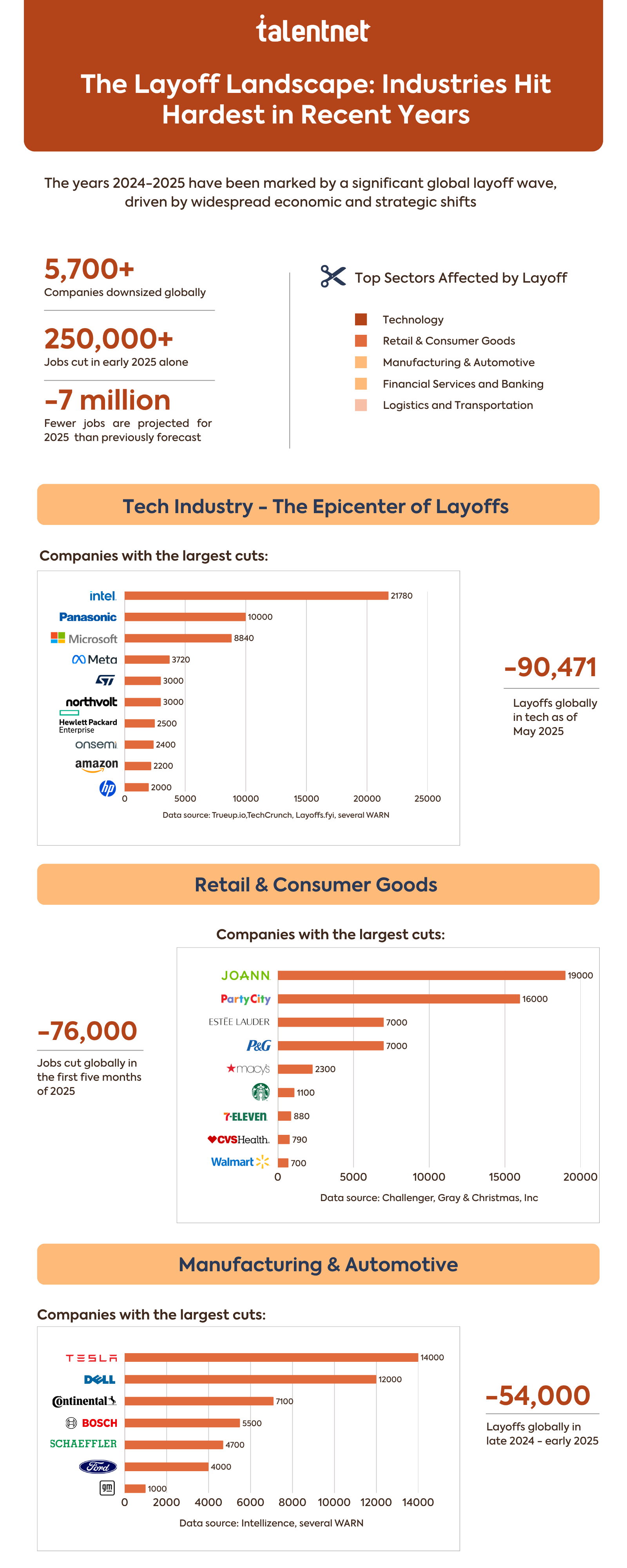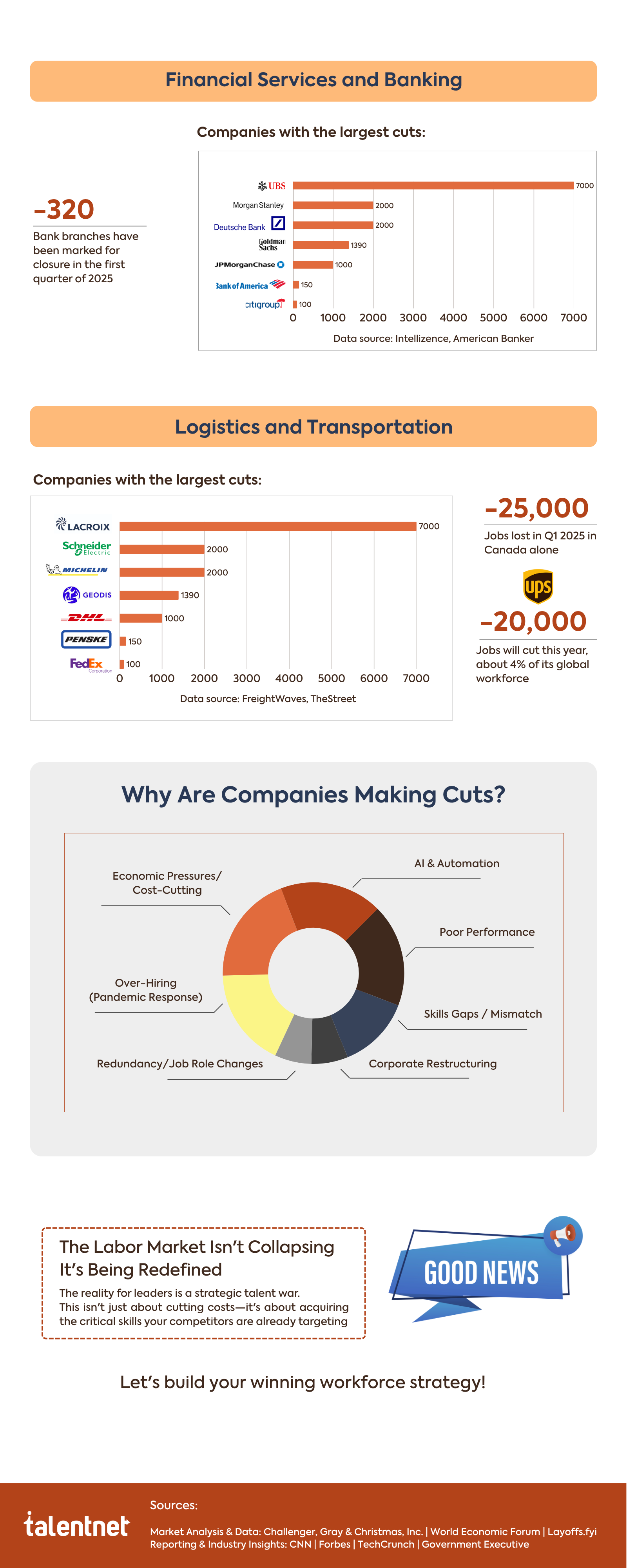Infographic Layoffs Statistics 2025: Industries Hit Hardest in Recent Years

Jul 4, 2025
Last updated on Dec 18, 2025
The first half of 2025 saw over 250,000 job cuts, but the real story is not in the raw layoffs statistics. These layoffs show a deep and needed shift in global strategy. For leaders, this disruption is a key moment. Companies that only cut costs will fall behind. The real winners will use this time to build agile, future-ready teams. They will turn big changes into a strong competitive edge through smart talent plans and retraining.

Every layoff notice creates waves, and the data on salary and involuntary turnover trends also paint a volatile HR picture that leaders need to be concerned about. Behind the headlines about the current layoffs is a mix of new technology, market shifts, and the urgent need to prepare your business for the future. The question is not if your industry will be affected—it is if you will come out stronger.
This is not just another report on job cuts. It is a strategic guide for leaders facing the biggest workforce change in decades. Understanding what is truly driving these layoffs—from AI adoption to industry-wide changes—gives you the clarity to turn workforce problems into a competitive advantage. It’s the context behind the layoffs statistics that matters most.
Top sectors affected by layoffs
The infographic below provides a high-level view of the numbers, but the real story is in the strategic shifts happening behind them. These are not random cuts; they are focused moves toward where future profits will be. In tech, the biggest tech layoffs are about getting “right-sized.” Companies are trading the large teams they hired during the pandemic for smaller, more skilled groups. The talent being let go often fits an old strategy, as we’ve seen that even good skills are not a shield against layoffs. Now, money is flowing into hiring specialists who can build and use new AI.
It is a similar story in the auto industry. The cuts there, contributing to the year’s biggest layoff totals, are due to a massive technology shift. Moving to electric vehicles is a huge change that makes old skills useless. Losing thousands of jobs in old supply chains is hard. But it’s needed to fund billions in new tech like batteries and software. These are the keys to the auto industry’s future. In retail and logistics, cutting office jobs means tasks are moving from people to software. As AI takes over work like inventory control and route planning, companies are removing the layers of management that supported the old, slower models. This strategic shift requires expert HR consulting to manage effectively.

Why the cuts? the shift to a new labor market
Wondering are layoffs increasing? The answer is complex. The job cuts detailed in the infographic are symptoms of a bigger cause: companies are rebuilding for a future with AI. Economic pressure just speeds up a change that was already happening. Leaders are not just cutting costs. They are making a trade: moving money from old jobs to invest in the skills needed for the future. This is not about doing less; it is about doing work in a new way.
The smartest companies are balancing two things at once. They are making targeted cuts to roles that can be automated. At the same time, they are creating and hiring for new jobs that require people to work with AI systems. The key reasons for this strategic realignment include:
- The need for AI integration: Companies are no longer just testing AI. They are building their main operations around it, a process that can be guided by analyzing the right workforce metrics. This requires a workforce that can develop, manage, and create with smart technology.
- The search for agility: Old, multi-level management is too slow for today’s world. Companies are creating flatter, faster structures where decisions can be made quickly.
- A new definition of “performance”: Job cuts are no longer just about how well a person does their work. They are about how well a job fits the company’s future plans. The key question has changed from “Does this person do their job well?” to “Is this job what we will need in three years?”

This leads to the good news often lost in the headlines: the labor market is not collapsing, it is being redefined. For every role that is automated, a new one appears that needs human skills like creativity and strategic thinking. This “Great Reallocation” of talent gives leaders a huge opportunity to build a strong edge over others. Instead of asking, “are there massive layoffs coming?” the better question is, “how do we capitalize on this shift?“
Leaders can embrace strategies like “quiet hiring” and focus on retraining. While managing departures, it’s crucial to consider the impact of layoffs on employees who remain and support those transitioning out with professional outplacement services. By focusing on these areas, you can attract the talent your rivals are letting go and build the workforce that will lead your industry for the next decade.

Thank you for your interest in our services.
Kindly check your mailbox to get the document.

Solve your HR problems!
6th Floor, Star Building, 33 Mac Dinh Chi, Saigon Ward, Ho Chi Minh city, Vietnam




